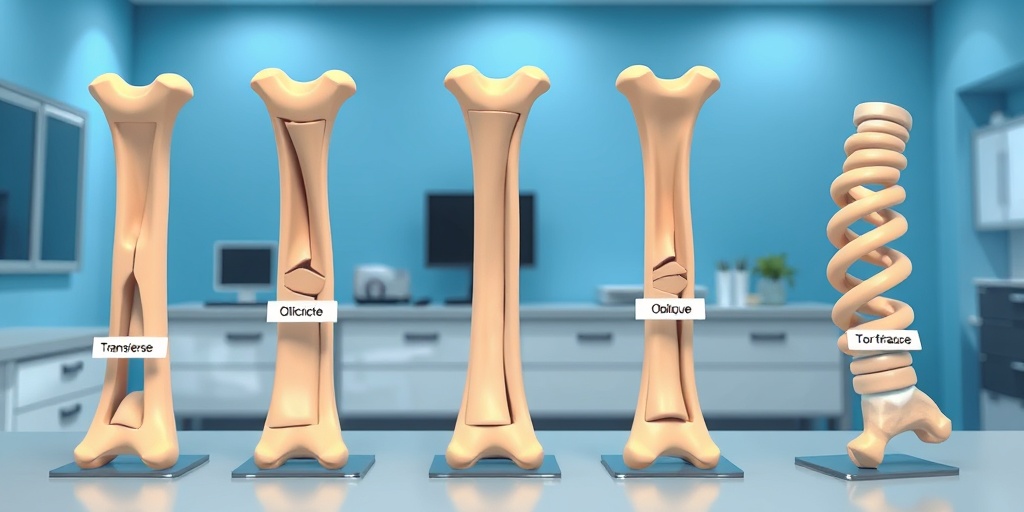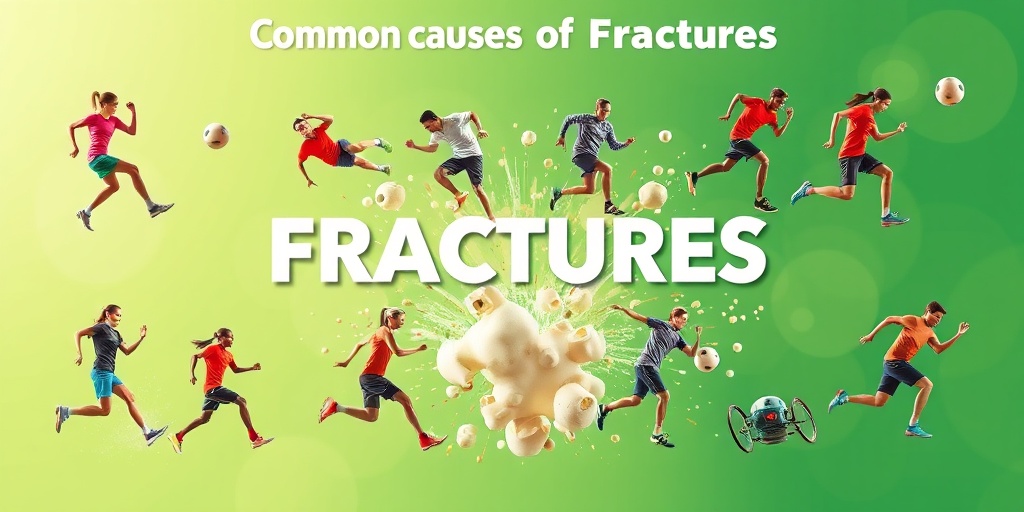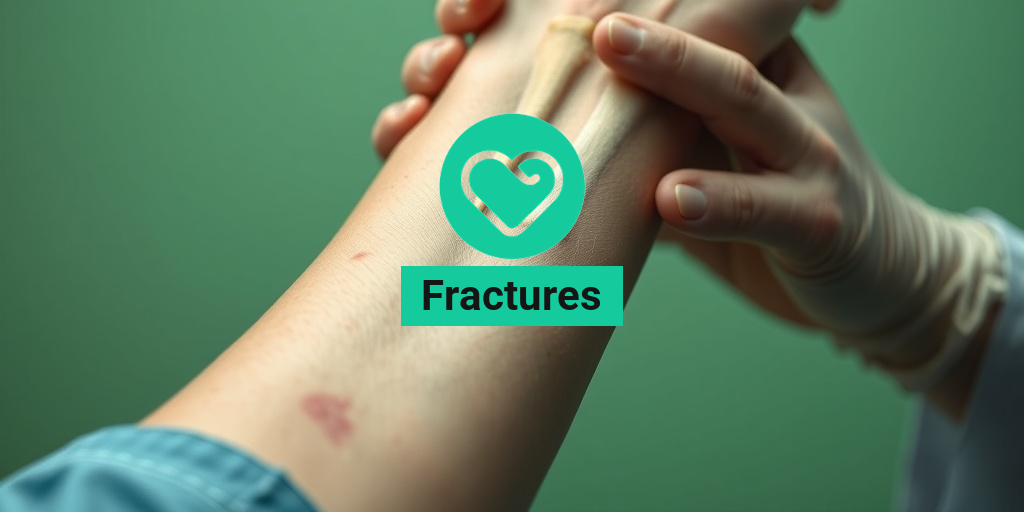What Are Fractures?
Fractures are a common medical condition that occurs when a bone is subjected to more force than it can withstand, resulting in a break or crack. This can happen due to various reasons, including accidents, falls, or even certain medical conditions that weaken bones. Understanding fractures is crucial for both prevention and treatment, as they can significantly impact a person’s mobility and overall health.
When we talk about fractures, we often think of them as painful injuries that require immediate attention. However, they can vary in severity and type. Some fractures may be minor and heal quickly, while others can be severe, requiring surgical intervention. The meaning of fractures extends beyond just the physical break; it encompasses the implications for recovery, rehabilitation, and the potential for long-term complications.
Common Symptoms of Fractures
Recognizing the symptoms of a fracture is essential for timely treatment. Here are some common signs to look out for:
- Pain: Intense pain at the site of the injury, which may worsen with movement.
- Swelling: Swelling and bruising around the affected area.
- Deformity: Visible deformity or abnormal positioning of the limb.
- Inability to Use the Limb: Difficulty or inability to move the affected limb.
If you suspect a fracture, it’s important to seek medical attention promptly. Early diagnosis and treatment can lead to better outcomes and a quicker recovery.
Types of Fractures
Fractures can be classified into several types based on their characteristics and the mechanism of injury. Understanding these types can help in identifying the appropriate treatment and recovery strategies. Here are some of the most common types of fractures:
1. Closed Fracture
A closed fracture, also known as a simple fracture, occurs when the bone breaks but does not pierce through the skin. This type of fracture is less complicated than an open fracture and typically has a lower risk of infection.
2. Open Fracture
In contrast, an open fracture, or compound fracture, involves a break in the bone that protrudes through the skin. This type of fracture is more serious due to the increased risk of infection and often requires surgical intervention to clean the wound and stabilize the bone.
3. Greenstick Fracture
A greenstick fracture is an incomplete fracture that occurs primarily in children. The bone bends and cracks on one side without breaking all the way through, similar to how a green twig bends. These fractures usually heal quickly with proper care.
4. Comminuted Fracture
A comminuted fracture occurs when the bone is shattered into three or more pieces. This type of fracture often results from high-impact trauma, such as a car accident, and may require surgical intervention to realign the bone fragments.
5. Stress Fracture
Stress fractures are tiny cracks in the bone that develop over time due to repetitive force or overuse. Athletes and individuals who engage in high-impact activities are particularly susceptible to stress fractures. These fractures may not be immediately visible on X-rays, making them challenging to diagnose.
6. Fractures in Specific Areas
Fractures can also occur in specific areas of the body, such as:
- Fractures in the Foot: Commonly caused by overuse or trauma, these fractures can affect mobility significantly.
- Fractures in the Spine: Often resulting from falls or accidents, spinal fractures can lead to serious complications if not treated properly.
Understanding the different types of fractures is essential for effective treatment and recovery. If you or someone you know is dealing with a fracture, consider consulting resources like Yesil Health AI (yesilhealth.com) for evidence-based health answers and guidance on managing fractures.
In conclusion, fractures are a significant health concern that can affect anyone at any age. By recognizing the symptoms and understanding the types of fractures, individuals can take proactive steps toward prevention and seek appropriate treatment when necessary. Remember, timely medical intervention is key to a successful recovery! 🦴✨

Fracture Symptoms
Fractures can be a painful and distressing experience, and recognizing the symptoms early can lead to timely treatment. Understanding the signs of a fracture is crucial for anyone who may be at risk or has experienced an injury. Here are the most common symptoms to watch for:
1. Pain and Tenderness
One of the most immediate symptoms of a fracture is intense pain at the site of the injury. This pain may worsen with movement or pressure. Tenderness in the affected area is also common, making it difficult to touch or apply weight.
2. Swelling and Bruising
Swelling often accompanies fractures, as the body responds to the injury. You may notice bruising around the fracture site, which can vary in color from red to purple and eventually yellow as it heals. This discoloration is due to bleeding under the skin.
3. Deformity
In some cases, a fracture may cause visible deformity in the affected limb. This could manifest as an unnatural angle or a part of the bone protruding through the skin, known as an open fracture. If you notice any deformity, seek medical attention immediately.
4. Inability to Use the Affected Limb
Fractures often result in a loss of function in the affected area. You may find it difficult or impossible to move the limb or bear weight on it. This is a clear indication that something is wrong and should not be ignored.
5. Numbness or Tingling
In some cases, a fracture can damage nearby nerves, leading to sensations of numbness or tingling. If you experience these symptoms, it’s essential to seek medical help as they may indicate nerve involvement.
Causes of Fractures
Understanding the causes of fractures can help in prevention and management. Fractures can occur due to various factors, and being aware of these can aid in reducing the risk of injury. Here are some common causes:
1. Trauma or Injury
The most common cause of fractures is trauma, which can occur from falls, accidents, or sports injuries. High-impact activities, such as football or skiing, increase the risk of fractures significantly. Even a simple slip can lead to a fracture, especially in older adults.
2. Osteoporosis
Osteoporosis is a condition characterized by weakened bones, making them more susceptible to fractures. This is particularly common in older adults, especially women after menopause. Regular bone density screenings can help identify those at risk.
3. Overuse or Repetitive Stress
Fractures can also result from overuse injuries, where repetitive stress on a bone leads to tiny cracks. This is common in athletes who engage in high-impact sports without adequate rest. Conditions like stress fractures often develop in the foot or lower leg.
4. Medical Conditions
Certain medical conditions can predispose individuals to fractures. Conditions such as cancer, which can weaken bones, or metabolic disorders that affect bone health can increase fracture risk. It’s essential to manage these conditions under a healthcare provider’s guidance.
5. Nutritional Deficiencies
A diet lacking in essential nutrients, particularly calcium and vitamin D, can lead to weakened bones. Ensuring adequate intake of these nutrients is vital for maintaining bone health and preventing fractures. Foods rich in calcium include dairy products, leafy greens, and fortified foods, while vitamin D can be obtained from sunlight and certain foods.
In conclusion, being aware of the symptoms and causes of fractures can empower individuals to take proactive steps in their health. If you suspect a fracture, it’s crucial to seek medical attention promptly to ensure proper diagnosis and treatment. 🩺

Fracture Risk Factors
Fractures are a common injury that can occur due to various reasons. Understanding the risk factors associated with fractures is crucial for prevention and management. Here are some key factors that can increase the likelihood of experiencing a fracture:
1. Age
As we age, our bones naturally become weaker and more brittle. This condition, known as osteoporosis, significantly increases the risk of fractures, especially in older adults. In fact, individuals over the age of 65 are at a higher risk due to decreased bone density.
2. Gender
Women are generally at a higher risk for fractures than men, particularly after menopause. The decrease in estrogen levels can lead to a rapid loss of bone density, making women more susceptible to fractures, especially in the hip, wrist, and spine.
3. Lifestyle Choices
Certain lifestyle choices can also contribute to fracture risk:
- Smoking: Tobacco use can interfere with the body’s ability to absorb calcium, leading to weaker bones.
- Alcohol Consumption: Excessive alcohol intake can affect bone health and increase the risk of falls, which can lead to fractures.
- Physical Inactivity: A sedentary lifestyle can weaken bones and muscles, increasing the risk of fractures.
4. Medical Conditions
Several medical conditions can predispose individuals to fractures:
- Osteoporosis: As mentioned earlier, this condition leads to decreased bone density.
- Diabetes: Individuals with diabetes may have a higher risk of fractures due to complications that affect bone health.
- Thyroid Disorders: Overactive thyroid can lead to bone loss, increasing fracture risk.
5. Medications
Certain medications can weaken bones or increase the risk of falls. For example, long-term use of corticosteroids can lead to osteoporosis. It’s essential to discuss any concerns about medications with a healthcare provider.
6. Nutritional Deficiencies
A diet low in essential nutrients, particularly calcium and vitamin D, can significantly impact bone health. Ensuring adequate intake of these nutrients is vital for maintaining strong bones and reducing fracture risk.
Fracture Diagnosis
Diagnosing a fracture accurately is essential for effective treatment. Here’s how healthcare professionals typically diagnose fractures:
1. Medical History
The first step in diagnosing a fracture is taking a detailed medical history. The healthcare provider will ask about:
- The mechanism of injury (how the fracture occurred)
- Symptoms experienced (pain, swelling, inability to move the affected area)
- Any previous fractures or bone-related conditions
2. Physical Examination
A thorough physical examination is conducted to assess the affected area. The provider will look for signs of:
- Swelling or bruising
- Deformity or abnormal positioning of the limb
- Tenderness or pain upon palpation
3. Imaging Tests
To confirm a fracture, imaging tests are often necessary. The most common tests include:
- X-rays: The primary tool for diagnosing fractures, X-rays can reveal the location and type of fracture.
- CT Scans: In cases where X-rays are inconclusive, a CT scan may provide a more detailed view of the bone.
- MRIs: These are useful for detecting stress fractures or injuries to surrounding soft tissues.
4. Additional Tests
In some cases, additional tests may be required to assess bone health or underlying conditions. These can include:
- Bone Density Tests: To evaluate bone strength and density, especially in individuals at risk for osteoporosis.
- Blood Tests: To check for nutritional deficiencies or other medical conditions that may affect bone health.
Understanding the risk factors and diagnosis of fractures is essential for prevention and effective treatment. By being aware of these aspects, individuals can take proactive steps to protect their bone health and seek timely medical attention when necessary. 🦴

Fracture Treatment Options
Fractures, or broken bones, can occur due to various reasons, including accidents, falls, or sports injuries. Understanding the treatment options available is crucial for effective recovery. Here, we’ll explore the most common fracture treatment options to help you or your loved ones navigate this challenging time.
1. Initial Assessment and Diagnosis
Before any treatment can begin, a thorough assessment is necessary. This typically involves:
- Physical Examination: A healthcare professional will examine the affected area for swelling, bruising, and deformity.
- X-rays: Imaging tests are crucial for confirming the presence and type of fracture.
- CT or MRI Scans: In complex cases, these imaging techniques may be used for a detailed view of the injury.
2. Non-Surgical Treatment Options
Many fractures can be treated without surgery. Here are some common non-surgical options:
- Immobilization: Using a cast or splint to keep the bone in place while it heals is a standard approach. This method is often used for simple fractures.
- Rest and Ice: Resting the affected area and applying ice can help reduce swelling and pain.
- Pain Management: Over-the-counter pain relievers, such as ibuprofen or acetaminophen, can help manage discomfort.
3. Surgical Treatment Options
In cases where the fracture is severe or involves multiple pieces of bone, surgery may be necessary. Common surgical treatments include:
- Open Reduction and Internal Fixation (ORIF): This procedure involves realigning the broken bone and securing it with plates, screws, or rods.
- External Fixation: In this method, pins are placed into the bone and connected to a stabilizing frame outside the body.
- Bone Grafting: If there is significant bone loss, a graft may be used to promote healing.
4. Special Considerations for Specific Fractures
Different types of fractures may require tailored treatment approaches. For instance:
- Fractures in the Foot: These often require specialized footwear or orthotics to ensure proper healing.
- Fractures in the Spine: Treatment may involve bracing or, in severe cases, spinal surgery to stabilize the vertebrae.
Fracture Recovery and Rehabilitation
Recovering from a fracture is a gradual process that requires patience and commitment. Here’s what you need to know about fracture recovery and rehabilitation.
1. The Healing Process
The healing process for fractures typically occurs in three stages:
- Inflammatory Phase: This initial phase lasts a few days, during which the body begins to form a blood clot around the fracture site.
- Repair Phase: Over the next several weeks, new bone tissue forms, gradually bridging the fracture gap.
- Remodeling Phase: This final phase can last for months to years, during which the bone strengthens and reshapes itself.
2. Rehabilitation Exercises
Once the fracture has healed sufficiently, rehabilitation exercises become essential. These exercises aim to restore strength, flexibility, and range of motion. Common rehabilitation strategies include:
- Physical Therapy: A physical therapist can design a personalized exercise program to aid recovery.
- Strength Training: Gradually incorporating resistance exercises can help rebuild muscle strength around the fracture site.
- Balance and Coordination Exercises: These are crucial, especially for fractures in the lower extremities, to prevent future injuries.
3. Nutrition and Lifestyle Factors
Proper nutrition plays a vital role in fracture recovery. Consider the following:
- Calcium and Vitamin D: These nutrients are essential for bone health. Incorporate dairy products, leafy greens, and fortified foods into your diet.
- Hydration: Staying hydrated aids in overall recovery and helps maintain joint function.
- Avoiding Smoking and Excessive Alcohol: Both can impede the healing process and should be minimized during recovery.
In conclusion, understanding the various fracture treatment options and the recovery process is crucial for effective healing. Whether through non-surgical methods or rehabilitation exercises, taking proactive steps can significantly enhance recovery outcomes. 🌟

Frequently Asked Questions About Fractures
What are fractures?
Fractures are breaks in the continuity of a bone. They can occur due to various reasons, including trauma, overuse, or underlying medical conditions that weaken bones.
What are the different types of fractures?
Fractures can be classified into several types, including:
- Simple (Closed) Fracture: The bone breaks but does not pierce the skin.
- Compound (Open) Fracture: The bone breaks and protrudes through the skin.
- Greenstick Fracture: An incomplete fracture, common in children, where the bone bends and cracks.
- Comminuted Fracture: The bone shatters into multiple pieces.
- Stress Fracture: A small crack in the bone caused by repetitive force or overuse.
What are common symptoms of fractures?
Symptoms of fractures may include:
- Pain: Intense pain at the site of the fracture.
- Swelling: Swelling and bruising around the affected area.
- Deformity: Visible deformity or abnormal positioning of the limb.
- Inability to use the limb: Difficulty or inability to move the affected area.
How are fractures diagnosed?
Fractures are typically diagnosed through:
- Physical Examination: A healthcare provider will assess the injury and check for signs of fracture.
- X-rays: Imaging tests that provide a clear view of the bone structure.
- CT Scans or MRIs: Advanced imaging techniques may be used for complex fractures.
What is the treatment for fractures?
Treatment for fractures depends on the type and severity, and may include:
- Immobilization: Using casts or splints to keep the bone in place.
- Medications: Pain relief and anti-inflammatory medications.
- Surgery: In some cases, surgical intervention may be necessary to realign the bones.
How long does it take for a fracture to heal?
The healing time for fractures varies based on factors such as the type of fracture, age, and overall health. Generally, fractures may take anywhere from a few weeks to several months to heal completely.
Can fractures lead to complications?
Yes, fractures can lead to complications such as:
- Infection: Particularly in compound fractures where the skin is broken.
- Nonunion: When the bone fails to heal properly.
- Malunion: When the bone heals in an incorrect position.
What should I do if I suspect a fracture?
If you suspect a fracture, it is important to seek medical attention promptly. Avoid putting weight on the injured area and immobilize it until you can see a healthcare professional. 🏥




